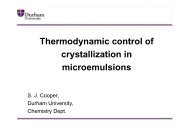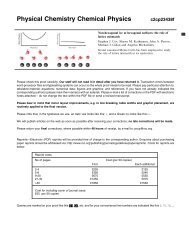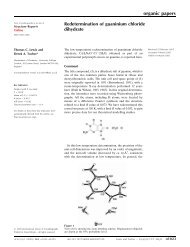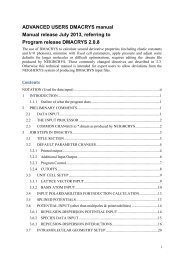An Introduction to the Theory of Crystalline Elemental Solids and ...
An Introduction to the Theory of Crystalline Elemental Solids and ...
An Introduction to the Theory of Crystalline Elemental Solids and ...
You also want an ePaper? Increase the reach of your titles
YUMPU automatically turns print PDFs into web optimized ePapers that Google loves.
14<br />
FIG. 5: (a) Schematic illustration <strong>of</strong> <strong>the</strong> relative filling <strong>of</strong> <strong>the</strong> d <strong>and</strong> sp densities <strong>of</strong> states as one<br />
moves from left <strong>to</strong> right across <strong>the</strong> transition metals. (b) Computed d <strong>and</strong> sp partial densities<br />
<strong>of</strong> states for several 4d transition metals, as obtained from a plane-wave pseudopotential DFT<br />
calculation within <strong>the</strong> LDA (computed by <strong>the</strong> authors).<br />
2.2 eV/a<strong>to</strong>m. This is quite close <strong>to</strong> <strong>the</strong> cohesive energy, E coh , <strong>of</strong> real sp metals which<br />
fall at around 1-2 eV/a<strong>to</strong>m [47] <strong>and</strong> quite good agreement considering <strong>the</strong> simplicity<br />
<strong>of</strong> <strong>the</strong> model. Indeed jellium can be modified [2, 48–50] <strong>to</strong> do better <strong>and</strong> <strong>to</strong> describe a<br />
range <strong>of</strong> properties (for example, phonon spectra, optical absorption, superconducting<br />
transition temperatures, <strong>and</strong> equations <strong>of</strong> states) by replacing our initial approximation<br />
<strong>of</strong> a uniform positive background with something less extreme, like, for example, a weak<br />
pseudopotential.<br />
4.1.3 Transition Metals <strong>and</strong> Tight Binding<br />
The transition metals belong <strong>to</strong> three series in <strong>the</strong> periodic table which correspond <strong>to</strong><br />
<strong>the</strong> progressive filling <strong>of</strong> 3d, 4d, <strong>and</strong> 5d states. The presence <strong>of</strong> <strong>the</strong> d electrons changes<br />
<strong>the</strong> picture <strong>of</strong> bonding in <strong>the</strong>se metals considerably from <strong>the</strong> simple metals <strong>and</strong> <strong>the</strong><br />
jellium description <strong>of</strong> metallic bonding no longer suffices. Notably <strong>the</strong> cohesive energies<br />
rise <strong>to</strong> significantly more than <strong>the</strong> 1-2 eV/a<strong>to</strong>m <strong>of</strong> <strong>the</strong> simple metals <strong>and</strong> follow a roughly<br />
parabolic variation across <strong>the</strong> transition metal series. For example, E coh goes from 4.36<br />
<strong>to</strong> 6.66 <strong>to</strong> 3.92 eV/a<strong>to</strong>m from Y <strong>to</strong> Ru <strong>to</strong> Pd [51].<br />
To underst<strong>and</strong> this variation in E coh it is useful <strong>to</strong> recognize that <strong>the</strong> electronic structure<br />
<strong>of</strong> <strong>the</strong> transition metals is comprised <strong>of</strong> two largely separate contributions: a broad freeelectron-like<br />
sp b<strong>and</strong>; <strong>and</strong> a considerably narrower d b<strong>and</strong>. We saw this already with<br />
<strong>the</strong> PDOS plot <strong>of</strong> Cu (Fig. 4) <strong>and</strong> we illustrate it again schematically in <strong>the</strong> <strong>to</strong>p part<br />
<strong>of</strong> Fig. 5(a). The d b<strong>and</strong> is narrower than <strong>the</strong> sp b<strong>and</strong> simply because <strong>the</strong> d valence<br />
orbitals <strong>and</strong> thus <strong>the</strong> overlap between <strong>the</strong>m is significantly smaller than <strong>the</strong> s <strong>and</strong> p<br />
valence orbitals. For example, <strong>the</strong> peak maximum <strong>of</strong> <strong>the</strong> 3d radial distribution for <strong>the</strong>







